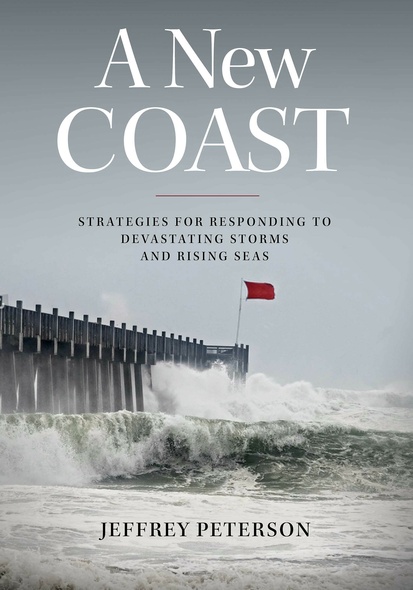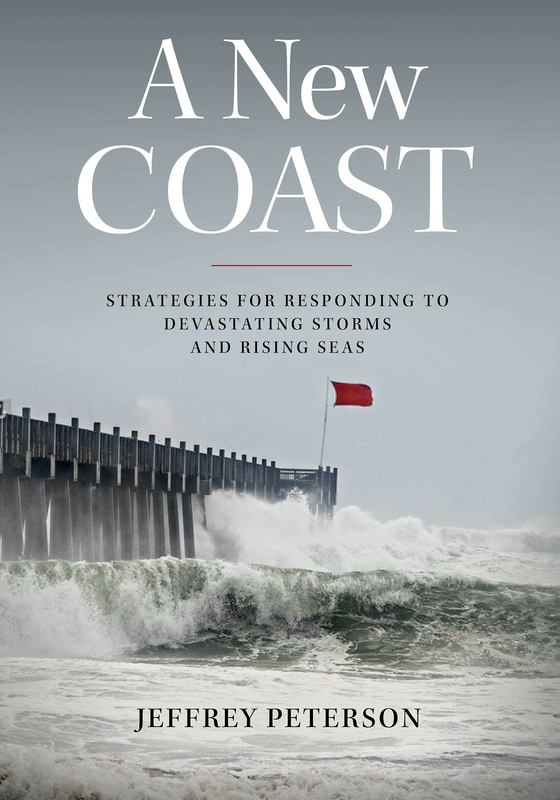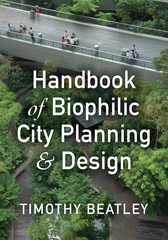Our shopping cart is currently down. To place an order, please contact our distributor, UTP Distribution, directly at utpbooks@utpress.utoronto.ca.
A New Coast
Strategies for Responding to Devastating Storms and Rising Seas
Island Press
“This is a timely book… [It] should be mandatory reading..." — Minnesota Star Tribune
More severe storms and rising seas will inexorably push the American coastline inland with profound impact on communities, infrastructure, and natural systems. In A New Coast, Jeffrey Peterson draws a comprehensive picture of how storms and rising seas will change the coast. Peterson offers a clear-eyed assessment of how governments can work with the private sector and citizens to be better prepared for the coming coastal inundation.
Drawing on four decades of experience at the Environmental Protection Agency and the United States Senate, Peterson presents the science behind predictions for coastal impacts. He explains how current policies fall short of what is needed to effectively prepare for these changes and how the Trump Administration has significantly weakened these efforts. While describing how and why the current policies exist, he builds a strong case for a bold, new approach, tackling difficult topics including: how to revise flood insurance and disaster assistance programs; when to step back from the coast rather than build protection structures; how to steer new development away from at-risk areas; and how to finance the transition to a new coast. Key challenges, including how to protect critical infrastructure, ecosystems, and disadvantaged populations, are examined. Ultimately, Peterson offers hope in the form of a framework of new national policies and programs to support local and state governments. He calls for engagement from the private sector and local and national leaders in a “campaign for a new coast.”
A New Coast is a compelling assessment of the dramatic changes that are coming to America’s coast. Peterson offers insights and strategies for policymakers, planners, and business leaders preparing for the intensifying impacts of climate change along the coast.
More severe storms and rising seas will inexorably push the American coastline inland with profound impact on communities, infrastructure, and natural systems. In A New Coast, Jeffrey Peterson draws a comprehensive picture of how storms and rising seas will change the coast. Peterson offers a clear-eyed assessment of how governments can work with the private sector and citizens to be better prepared for the coming coastal inundation.
Drawing on four decades of experience at the Environmental Protection Agency and the United States Senate, Peterson presents the science behind predictions for coastal impacts. He explains how current policies fall short of what is needed to effectively prepare for these changes and how the Trump Administration has significantly weakened these efforts. While describing how and why the current policies exist, he builds a strong case for a bold, new approach, tackling difficult topics including: how to revise flood insurance and disaster assistance programs; when to step back from the coast rather than build protection structures; how to steer new development away from at-risk areas; and how to finance the transition to a new coast. Key challenges, including how to protect critical infrastructure, ecosystems, and disadvantaged populations, are examined. Ultimately, Peterson offers hope in the form of a framework of new national policies and programs to support local and state governments. He calls for engagement from the private sector and local and national leaders in a “campaign for a new coast.”
A New Coast is a compelling assessment of the dramatic changes that are coming to America’s coast. Peterson offers insights and strategies for policymakers, planners, and business leaders preparing for the intensifying impacts of climate change along the coast.
This is a timely book… [It] should be mandatory reading for all persons seeking election to high public office. Followed by a test, with posted grades.
A New Coast is a compelling assessment of the dramatic changes that are coming to America's coast. Peterson offers insights and strategies for policymakers, planners, and business leaders preparing for the intensifying impacts of climate change along the coast.’
Peterson ... has written a comprehensive new national policy approach to dealing with sea level rise, a roadmap for reforming the U.S.’s broken flood insurance system and steering development away from increasingly risky coastal areas.
Peterson argues persuasively and passionately that coastal communities can no longer force the coast to adapt to an entrenched occupation of the shoreline; rather, communities must adapt to the reality of invasive seas.
It is an important work that speaks to the need for a national program to cope with rising seas and more intense storms along our shores …. this volume can serve as an invaluable tool for government officials and private citizens concerned with the impending challenges facing coastal regions in the United States and willing to take action.
The central message of this book, namely, creating a national program for a more resilient and adaptable coast, is highly relevant.’
Any reader concerned about the increasing challenges of coastal destruction, the financial disaster which is the National Flood Insurance Program, or the protection of priceless lives, ecosystems, and the national economy will have no regrets reading A New Coast, a most impressive treatment of all topics relating to managing the risks to the ocean shores of America’s coastal states.
Communities along the American coast face hard choices on how to deal with storms and rising seas. A New Coast will help them manage these risks as well as guide the federal government in supporting this important effort.
Risks to our coasts from storms and rising seas have been known for decades, but efforts to prepare for these threats have been limited. A New Coast offers a timely and thoughtful framework for governments, businesses, and organizations to work together to meet these challenges. Peterson tackles the difficult challenge of linking science and experience from devastating storms with forward-thinking public policy and exhorts us to choose leadership over crisis management.
This unbelievably comprehensive and well-researched book covers everything from the drivers of sea level rise and the range of its impacts to existing programs and solutions—and concludes with arguments for a new national program to prepare for more severe storms and rising seas. This book is a must-read for coastal management planning and for action at multiple scales.
A New Coast is timely and a very important look at the policy challenges posed by ever-rising sea level in addition to increased flooding from extreme weather events. It is thorough, well researched, up-to-date, and thought provoking. Jeff Peterson is very familiar with U.S. policy on the topic and qualified to propose big change, which he does, unflinchingly.
Enlightening. Traditional interpretations of 'coastal flooding' are being superseded quickly by the realities of storms and sea level rise. Peterson offers an incredibly thoughtful blueprint for federal leadership to manage these unprecedented changes to our nation’s coastline. His remedies are daunting, yet practical and hopeful. One can only hope that future presidents, governors, mayors, and business leaders will heed his call to action. The economic, ecological, and cultural health of our coastal communities is at stake.
This important and comprehensive book is a must-read for coastal policymakers who are grappling with impacts from rising seas and more intense storms. It captures not only the challenges communities are facing due to climate change, but also useful examples and policy recommendations for advancing adaptation efforts at all levels of government.
Jeffrey Peterson has 40 years of experience in environmental policy development and program management, particularly focused on water issues. Most recently he was Senior Advisor in the Environmental Protection Agency (EPA) Office of Water responsible for climate change policy. In that capacity he co-chaired the EPA Sea Level Rise Workgroup and was a member of the Federal Interagency Sea Level Rise Workgroup. He also worked for almost four years at the White House Council on Environmental Quality (CEQ) during the first Obama term. At CEQ, he co-chaired the Interagency Water Resources and Climate Change Workgroup and authored the first national plan addressing water resources management and climate change. Returning to EPA in 2012, he chaired the National Water Program Climate Change Workgroup and served for five years as the Federal co-chair of the Climate Change and Water Workgroup of the Federal Advisory Committee on Water Information (ACWI). Before joining the EPA in 1995, he worked for the U.S. Senate Committee on Environment and Public Works.
Preface
Introduction
Part I: A Warming Climate Drives Coastal Storms and Rising Seas
Chapter 1. Coastal Storms, Coastal Nightmare
Chapter 2. Sea Level Rise Projections: Trending Upward
Chapter 3. Measuring the Shifting Coast
Part II: Storms and Rising Seas Disrupt the American Coast
Chapter 4. Scale and Economic Cost of the Coming Inundation
Chapter 5. Coastal Storm and Sea Level Rise Risks to Critical Infrastructure
Chapter 6. Coastal Ecosystems Facing Inundation: Wetlands and Beaches
Chapter 7. Private Sector Losses as Seas Rise: Tourism, Fishing, and Energy
Part III: A Nation Unprepared for Coastal Storms and Rising Seas
Chapter 8. The Politics of Coastal Storms and Rising Seas
Chapter 9. National Flood Insurance Program: Coastal Misdirection
Chapter 10. Coastal Disaster Planning: Preparing for the Wrong Hazard
Chapter 11. Coastal Management Problems: Overcommitted and Underfunded
Chapter 12. National Planning for Climate Change: An Answer to Coastal Inundation?
Part IV: States, Communities, and Businesses Cope with Coastal Storms and Rising Seas
Chapter 13. Novel Challenges of Storms and Rising Seas
Chapter 14. State and Community Choices in Preparing for a Changing Coast
Chapter 15. Relocation: Often the Inevitable Choice
Chapter 16. Social and Psychological Dimensions of Storms and Rising Seas
Chapter 17. Business Community Response to Storms and Rising Seas
Part V: Campaign for a New Coast
Chapter 18. Framework for a National Storm and Sea Level Rise Program
Chapter 19. Funding Coastal Storm and Sea Level Rise Preparedness
Chapter 20. Campaign for a New Coast
Conclusion
Acknowledgements
Appendices
Endnotes
Introduction
Part I: A Warming Climate Drives Coastal Storms and Rising Seas
Chapter 1. Coastal Storms, Coastal Nightmare
Chapter 2. Sea Level Rise Projections: Trending Upward
Chapter 3. Measuring the Shifting Coast
Part II: Storms and Rising Seas Disrupt the American Coast
Chapter 4. Scale and Economic Cost of the Coming Inundation
Chapter 5. Coastal Storm and Sea Level Rise Risks to Critical Infrastructure
Chapter 6. Coastal Ecosystems Facing Inundation: Wetlands and Beaches
Chapter 7. Private Sector Losses as Seas Rise: Tourism, Fishing, and Energy
Part III: A Nation Unprepared for Coastal Storms and Rising Seas
Chapter 8. The Politics of Coastal Storms and Rising Seas
Chapter 9. National Flood Insurance Program: Coastal Misdirection
Chapter 10. Coastal Disaster Planning: Preparing for the Wrong Hazard
Chapter 11. Coastal Management Problems: Overcommitted and Underfunded
Chapter 12. National Planning for Climate Change: An Answer to Coastal Inundation?
Part IV: States, Communities, and Businesses Cope with Coastal Storms and Rising Seas
Chapter 13. Novel Challenges of Storms and Rising Seas
Chapter 14. State and Community Choices in Preparing for a Changing Coast
Chapter 15. Relocation: Often the Inevitable Choice
Chapter 16. Social and Psychological Dimensions of Storms and Rising Seas
Chapter 17. Business Community Response to Storms and Rising Seas
Part V: Campaign for a New Coast
Chapter 18. Framework for a National Storm and Sea Level Rise Program
Chapter 19. Funding Coastal Storm and Sea Level Rise Preparedness
Chapter 20. Campaign for a New Coast
Conclusion
Acknowledgements
Appendices
Endnotes







